The flowerhorn cichlid is without a doubt an eye-catching fish, featuring an oversized nuchal hump, bright colors, and a unique shape.
This hybrid was born from the combination of the blood parrot and red devil cichlids.
There are four variations, with the red dragon flowerhorn being the most common.

Flowerhorns come with a reputation for aggression.
They are, after all, a cichlid, and territorial aggression is one of the main challenges in keeping these fish with others.
However, you can pair them with an array of equally interesting tank mates if you take care to provide the right environment.
Getting the Tank Right
Most “issues” with aggression in fish pairings can be tempered by paying attention to tank size, keeping stable water conditions, feeding your fish adequately, and adding hiding spaces, or breaking the line of sight.
If these conditions are not met, the fish can become aggressive.
Tank Size
Cramped conditions lead to stress. Flowerhorns reach an adult length of 12 to 16 inches (30-40 cm) and need a minimum tank size of 70 gallons.
This intelligent species is immensely territorial and needs room to explore.
Add a second flowerhorn, and you should double the tank size.
Place another large species with them, and you can plan on around 200 gallons.
Water Parameters
Fluctuating water conditions will also stress your fish. Stick to the following water parameters to suit your flowerhorn and keep them stable:
- Temperature: 80 to 86°F (26.6-30°C)
- pH: 7 to 8
- Hardness: 8 to 20 dGH.
The high temperature required by these fish can sometimes make it difficult to pair them with another species.
Remember that stress can be caused by keeping fish at the outer edge of their thresholds, so keep the levels where they overlap.
Feeding
Not enough food or imbalanced nutrients can prompt fish to seek nutrition in their environment, sometimes to the detriment of their tank mates.
Flowerhorns need to be fed three times a day. Plant-based pellets and similar foods make up the base of their diet, with high-quality protein foods as supplements.
Some tank mates have different nutritional needs or feeding times.
Flowerhorns can greedily grab the lion’s share of food, so make sure all fish are receiving what they need.
Equipment and Decorations
Inadequate hiding spaces can lead to conflicts that could be avoided if the fish could not see one another.
Any decorations you add should be large, sturdy, and well secured. The flowerhorn loves to “redecorate” its environment.
Plan for a sturdy canister filtration system to accommodate the size of the tank and the amount of waste these big fish can produce. Clean water makes for happy fish.
Selecting Tank Mates
When pairing your flowerhorn, look for fish that are:
- Similarly sized
- Able to swim away quickly or hide
- Have similar temperaments.
Avoid:
- Fish smaller than 10 inches (25 cm) if your flowerhorn is full-grown
- Fish that need a quiet, peaceful environment
- Most invertebrates.
Even if you follow all recommendations, you may still find that the fish do not get along.
Flowerhorns have big personalities, but also individual inclinations. Some get along with tank mates while others simply want to be left alone.
Being prepared for this and having a backup plan is always a good idea.
Recommended Tank Mates for Flowerhorn
Now, here are some of our favorite fish to pair with the flowerhorn.
1. Oscars (Astronotus ocellatus)

Minimum Tank Size: 55 gallons
The oscar’s reputation as a lively, interactive fish with a tough personality makes it a tempting choice.
Consider this pairing only with a fully grown oscar that is large and strong enough to counter any flowerhorn aggression.
A smaller oscar may wind up on the losing side of any confrontation.
Add the oscar to the tank first to allow it to establish territory, claim food, and lessen the chances of the flowerhorn pushing it around.
The oscar’s water pH and hardness requirements fall into line with the flowerhorn but keep the temperature at the upper end of the oscar’s range, around 80 degrees (26.6°C) to overlap.
2. Arowana (Osteoglossum bicirrhosum)
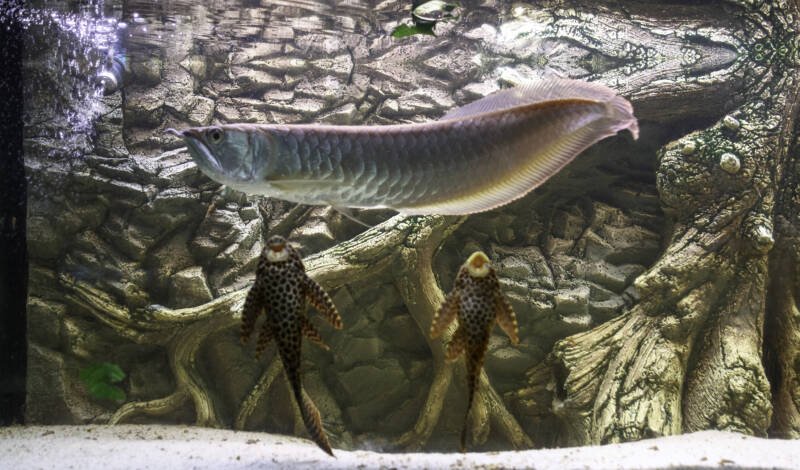
Minimum Tank Size: 250 gallons
The arowana is a highly aggressive predator.
They are large, powerful swimmers that reach up to three feet (91 cm) in length and need significant space to develop properly.
Their diet consists of live and frozen meaty foods, so consider pairing a smaller arowana with a larger flowerhorn so that the arowana does not mistake its tank mate for food.
Arowanas are highly sensitive to changes in water conditions, and their parameters and the flowerhorn’s overlap in a narrow range.
Keep the temperature toward the higher end of the arowana’s range, the pH at 7 or just above, and the hardness at 8 dGH.
3. Midas Cichlid (Amphilophus citrinellus)
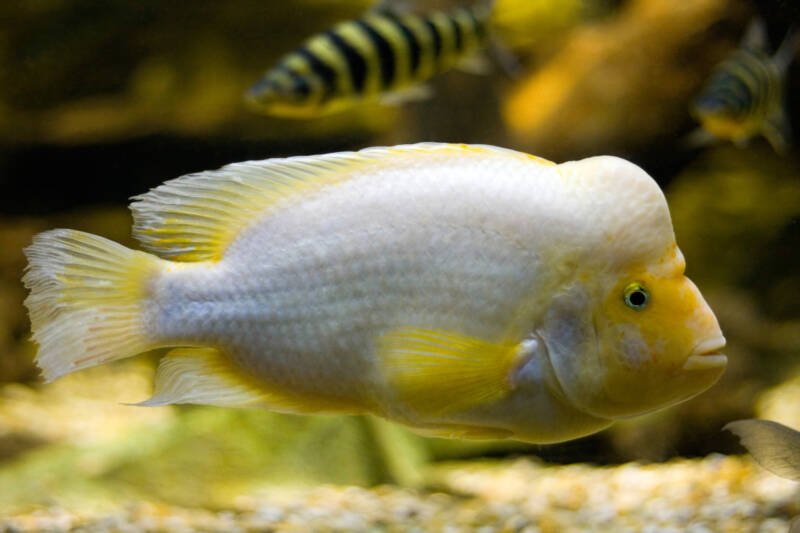
Minimum Tank Size: 60 gallons
The midas cichlid is another large species, reaching an adult length of 14 inches (35 cm).
As they and the flowerhorn favor similar diets, feeding is easy.
Midas cichlids are highly territorial and become aggressive when breeding, so keep that in mind if you have a male and female in the tank.
These fish stake out and guard larger territories than do other cichlids, so a big tank is essential.
You will need to maintain the water pH right around 7 and the temperature between 80 and 82°F (26.6-27.7°C) so that these two fish both get the parameters they need.
4. Firemouth Cichlid (Thorichthys meeki)
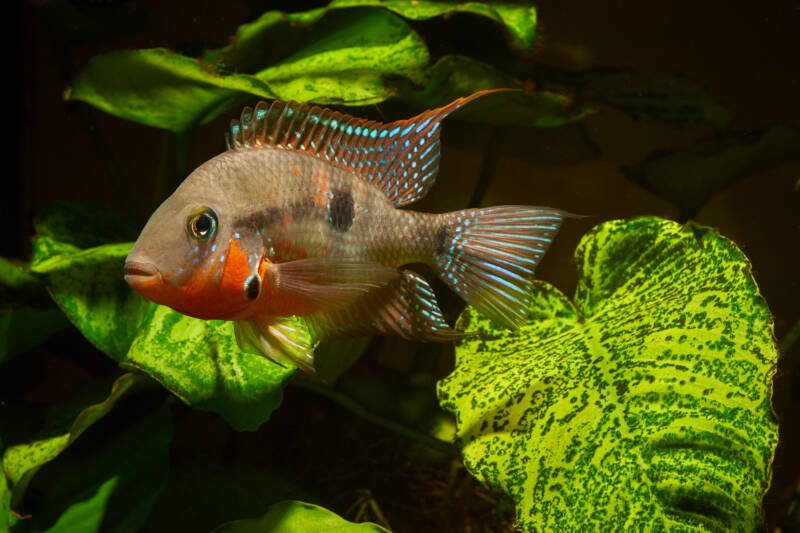
Minimum Tank Size: 30 gallons
If your flowerhorn is smaller, the firemouth may be a good match.
Maxing out between five to six inches in length (12-15 cm), their preferred water conditions mesh perfectly with the flowerhorn’s.
These omnivores love to eat, so feed them a few times a day to spread out the nutrition.
Provide this fish with plenty of hiding places that they can stake out as their own.
This easygoing fish gets along well with tank mates but can become aggressive if kept in too small of a tank or with inadequate water conditions or food.
5. Parrot Cichlid (hybrid)
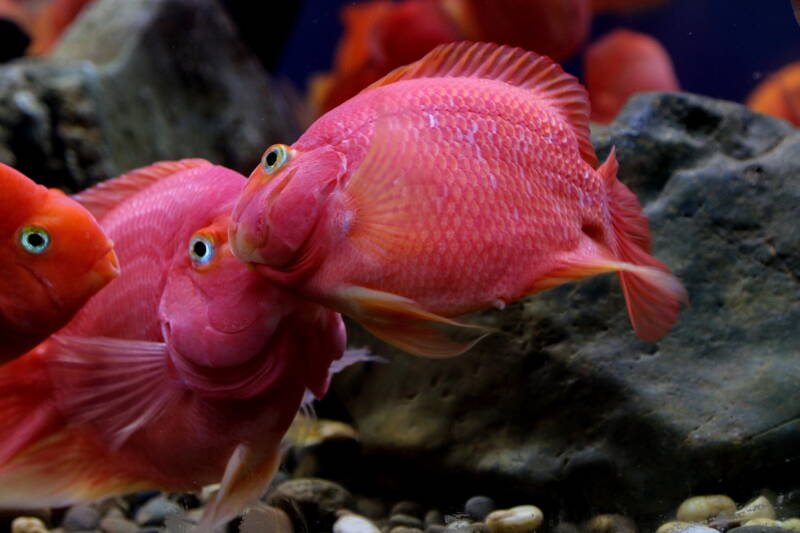
Minimum Tank Size: 30 gallons
Another hybrid, the parrot cichlid has genetic deformities that set their teeth deep within their throat, which allows them to break up food but does little for self-defense.
As a result, they are messy eaters and generate a fair amount of waste. These fish do best with sinking pellets as they cannot feed easily at the water surface.
Keep these smaller, six to eight-inch (15-20 cm) fish with smaller flowerhorns.
Parrots need a group and a tank with hiding spaces to be confident and less aggressive.
Set the water temperature near the upper end of the parrot’s range.
6. Blue Acara (Andinoacara pulcher)
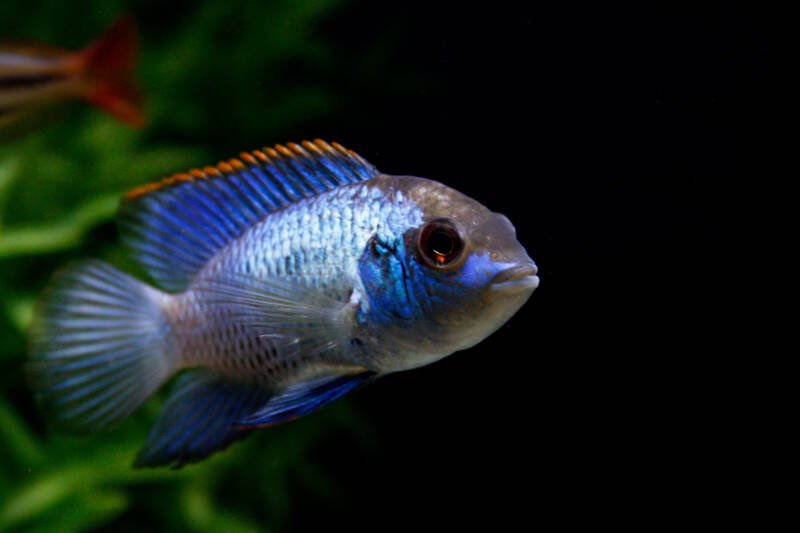
Minimum Tank Size: 30 gallons
The blue acara is among the more peaceful of the cichlid species. As such, it gets along well with many tank mates, the flowerhorn included.
These long-lived fish grow to a length of seven inches (18 cm), which is a bit of a disadvantage against an adult flowerhorn.
Introduce a fully grown acara for the best chance of success. If you have more than one acara, keep them in even numbers.
There is a narrow range of pH level overlap between the two species. Keep it between 7 and 7.5 and test the water regularly.
A steady water temperature between 80 and 82°F or 26.6-28°C is best.
7. Green Terror Cichlid (Andinoacara rivulatus)

Minimum Tank Size: 50 gallons
The aptly named green terror is a beautifully colored cichlid with a personality like no other.
They grow from eight to 12 inches in length (30 cm) and match well with the flowerhorn in water requirements, just keep the temperature nudged toward 80°F or 26.6°C.
This territorial fish is especially sensitive to poor tank conditions, which will ramp up aggressive behavior.
Place larger decorations in the tank to act as line-of-sight barriers.
The green terror will eat just about anything but leans toward the carnivorous side, as opposed to your flowerhorn’s more vegetable-based diet.
8. Bichir (Polypterus spp.)
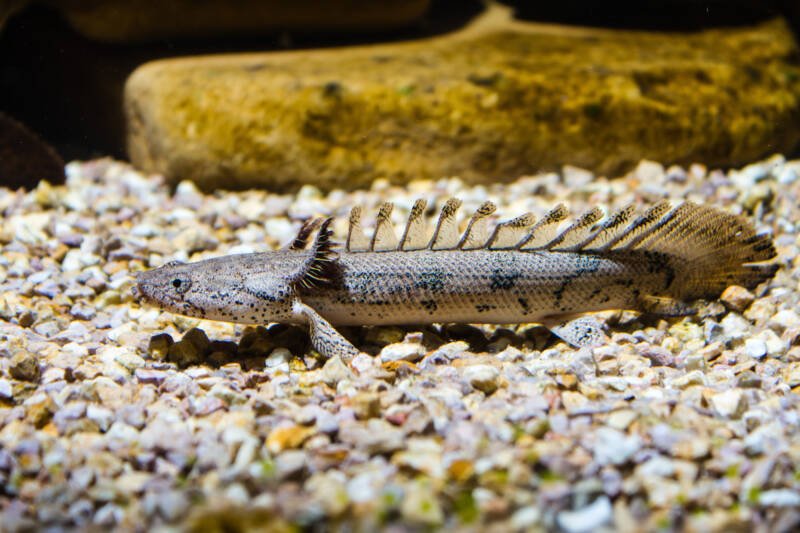
Minimum Tank Size: 90 gallons
Go prehistoric with the bichir. These unique fish occupy the tank bottom, keeping out of the way of the flowerhorn.
Plan for a large tank as bichir can reach up to two feet (60 cm) in length and allow them to access the water surface to breathe.
Bichirs are accustomed to murky waters with poor visibility.
They have poor eyesight and rely on their sense of smell and a special organ that detects electricity in the water to find food.
These carnivores need live foods and require a nocturnal feeding schedule.
9. Silver Dollars (Metynnis argenteus)
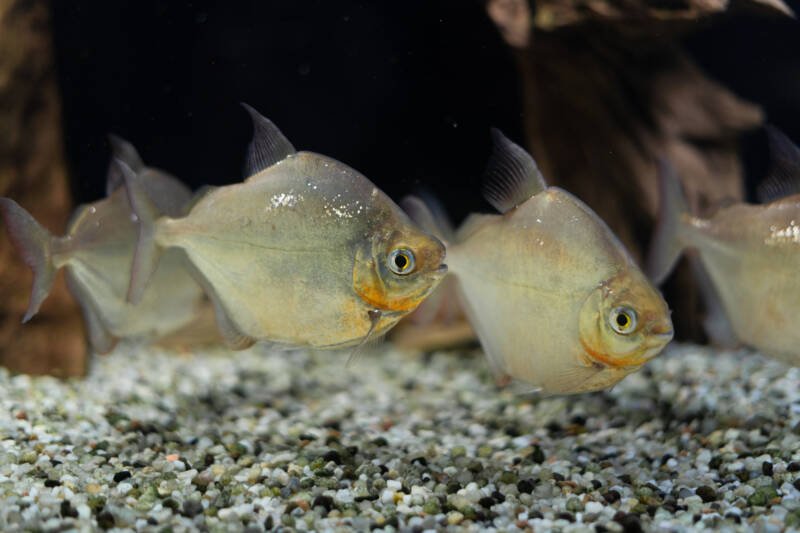
Minimum Tank Size: 75 gallons (for five fish)
Although the silver dollar is a smaller fish, around six inches (15 cm) in length, it is quick and can stay out of trouble in a tank of smaller flowerhorns.
If kept in a school of at least five or six, they exhibit confidence and have some protection.
These fish have pleasant personalities and do not often show aggression toward tank mates.
Diet-wise, the silver dollar and flowerhorn are both omnivores with a heavy focus on vegetable matter, so feeding is easy.
Water-wise, keep the temperature between 80 and 82°F (26.6-28°C) and the pH near neutral.
10. Iridescent Shark (Pangasianodon hypophthalmus)
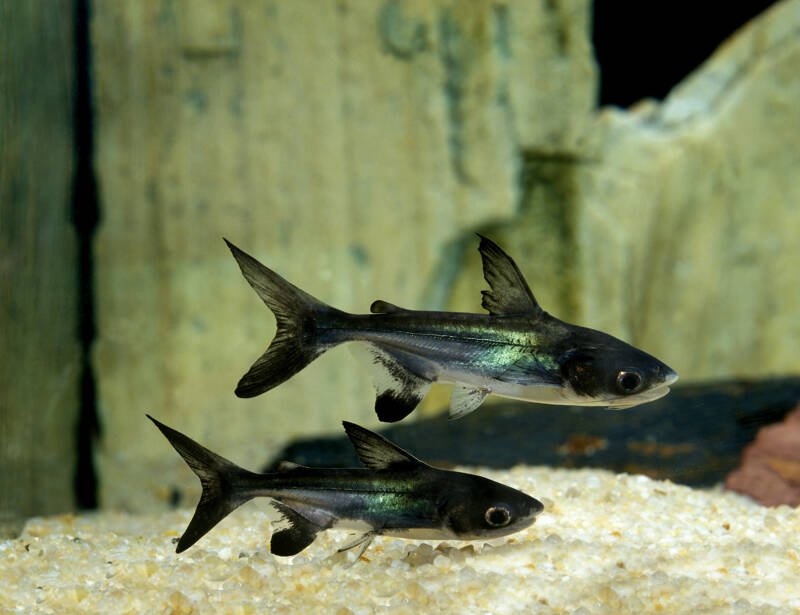
Minimum Tank Size: 300 gallons
The tough-sounding iridescent shark is actually a peaceful catfish.
These fish live for 20 years and reach an immense size of three to four feet (0.9-1.2 m)!
As if that did not already make for a significant tank size, these schooling fish do best in groups. Otherwise, they are nervous and jumpy.
Iridescent sharks like the water cooler than the flowerhorn, with an upper range of 79°F (26°C).
They need special high-quality food that covers their nutritional needs. Ensure that this food reaches the bottom of the tank, so these big fish get enough to eat.
11. Jack Dempsey (Rocio octofasciata)
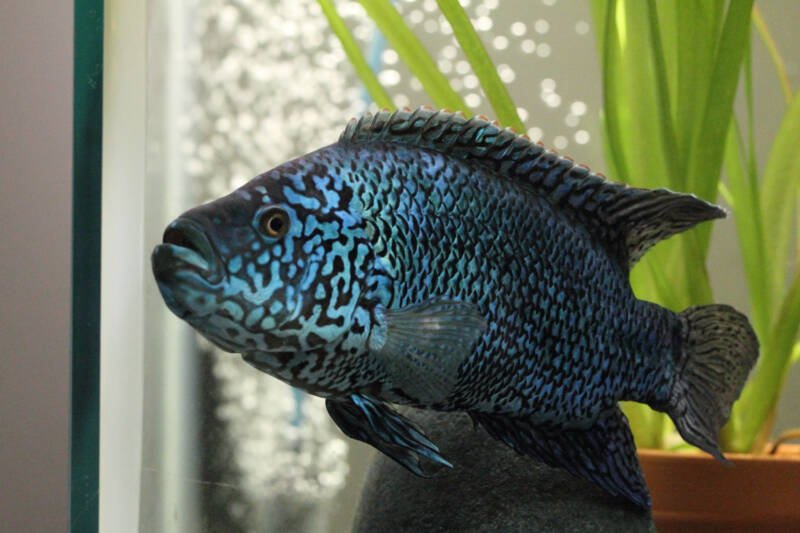
Minimum Tank Size: 55 gallons
If you want to pair a tough fish with another tough fish, then a flowerhorn/Jack Dempsey pairing may be it.
Dempseys are strong, carnivorous predators that match size-wise with the flowerhorn, ranging from 10 to 15 inches fully grown (25-38 cm).
Of all the fish listed, the Dempsey is most compatible with the flowerhorn in terms of water temperature.
Add some cave features for these highly territorial fish to claim and keep only one male in the tank to reduce aggression.
Take care when feeding Dempseys and flowerhorns together as they have different nutritional needs.
12. Armored Catfish (Loricariidae)
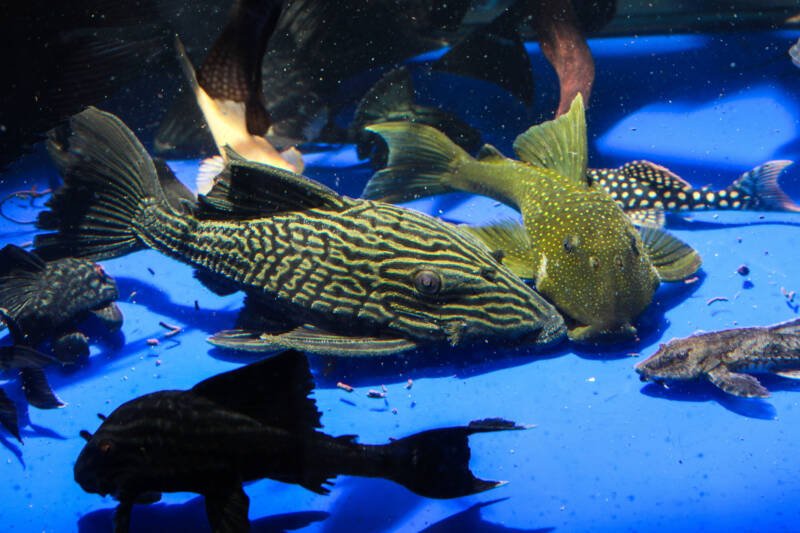
Minimum Tank Size: 50 gallons
Armored catfish work well with the flowerhorn for a few reasons.
First, they have sturdy, thick plates on their backs as well as sharp spines they can extend when threatened, which give protection from curious flowerhorns.
Second, these bottom dwellers’ primary concern is food, not fighting.
They are nocturnal and will be active when your flowerhorn is at rest.
There are several species that range in size from 12 to 20 inches (30-50 cm), and they adapt to a wide range of water conditions, which fits well with the flowerhorn.
13. Black Pacu (Colossoma macropomum)

Minimum Tank Size: 600 gallons
Now, we are in big fish territory – the black pacu measures up to four and a half feet fully grown (1.4 m).
They are shoaling fish when young, but solitary when older. These fish love a varied, but mostly vegetable diet, much as the flowerhorn.
However, they are omnivores that will eat what fits in their mouths. Make sure your flowerhorns are large-sized so they do not become food for the pacu.
The pacu and flowerhorn favor similar water parameters. Prepare for a large tank with vigorous filtration to handle the size of and waste produced by this fish.
14. Red Devil Cichlid (Amphilophus labiatus)
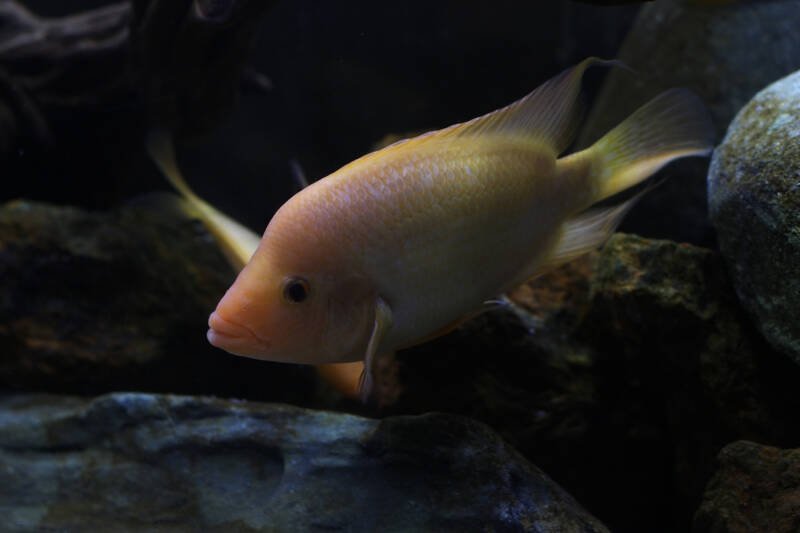
Minimum Tank Size: 55 gallons
If you are looking for a big cichlid to match with your flowerhorn, check out the comparably sized red devil.
Their temperament runs the gamut of relatively easygoing to downright mean. Keep an eye on interactions with your flowerhorn for signs of aggression.
As far as tank setup, the biggest challenge will be with water temperature and pH.
There is a slight temperature overlap at the upper region of the red devil’s range. Keep the pH near neutral.
Pairing the red devil with the flowerhorn also means no plants in the tank, as the devil will routinely damage them.
15. Jaguar Cichlid (Parachromis managuensis)

Minimum Tank Size: 125 gallons
The jaguar cichlid matches well with the flowerhorn in many aspects. Size-wise, they each grow to around 16 inches (40 cm), so one will not overpower the other.
Water parameters match well if you keep the temperature toward the upper end of the jaguar’s range.
If you have a male and female jaguar, be aware that these higher temperatures may trigger breeding, which can result in aggression.
The only area where they differ is in their diets. Jaguars are carnivores that need regular, protein-rich foods while omnivorous flowerhorns need both meaty and vegetable foods.
16. Texas Cichlid (Herichthys cyanoguttatus)
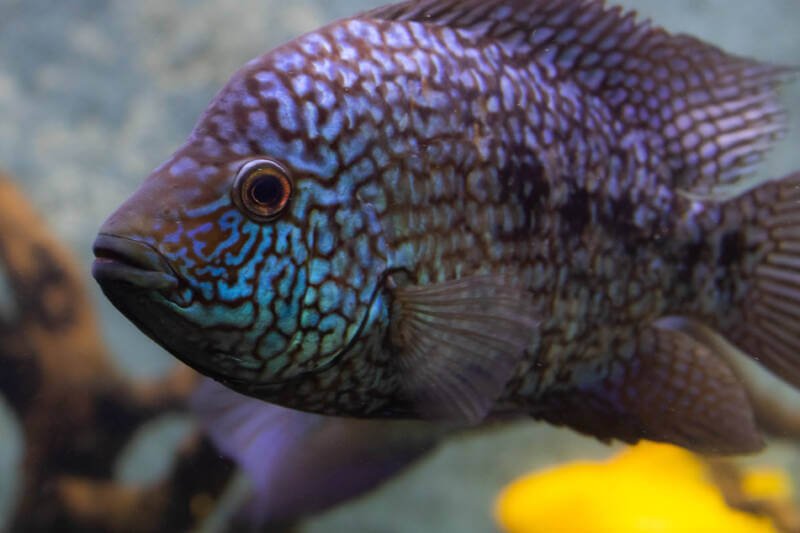
Minimum Tank Size: 55 gallons
The Texas cichlid is long-lived, feisty, and comes in a variety of colors.
These firecrackers start out small and quickly grow to 12 inches in length (30 cm).
They need a good-sized tank when kept on their own, but their territorial nature means a significant upsize if you keep them with the flowerhorn. Both fish are omnivores that enjoy the same foods.
The Texas cichlid and flowerhorn are less compatible in water temperature.
The flowerhorn develops best in warmer waters, whereas the upper range of the Texas cichlid is 78°F (25°C).
Pairing the two means keeping the water on the outer edges of each fish’s range.
17. Plecos (Hypostomus plecostomus)

Minimum Tank Size: 100 gallons
Plecos are one of the most peaceful fish you can pair with a flowerhorn.
The bottom-dwelling common pleco reaches a whopping two feet in length (61 cm) and is only aggressive when protecting territory.
There are smaller species available, but those would not be compatible with the flowerhorn.
Another plus to this fish: they are most active when the flowerhorn is resting, which keeps them from many confrontations.
Keep the pH neutral, the water warm, and the substrate soft to suit your pleco.
Ensure adequate hiding spaces and a strong filter to support the hefty bioload the pleco produces.
Closing Thoughts
The variety, interest, and activity of a cichlid tank are undeniable, especially one showcasing the flowerhorn.
Adding tank mates means gathering information and making the right choices to build the most peaceful tank possible.
Take the time to look into each potential tank mate.
Learn what they need to be happy and healthy and strive to set up your tank in a manner that satisfies the needs of all the inhabitants.
Keeping aggression to a minimum requires stable tank conditions, adequate food, and attention to the individual needs of each species.
Best of luck!
We would love to hear from you!
What have been your most successful flowerhorn pairings?